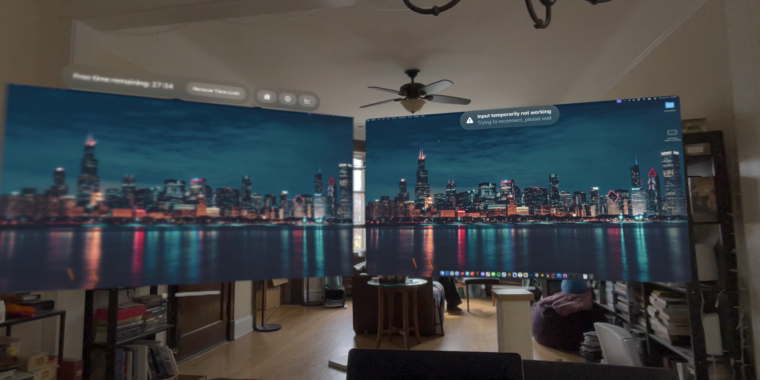Samuel Axon
Apple’s Vision Pro headset holds the promise to be a powerful extension of your Mac workflow, but the Mac integration it shipped with is just neat, not a big step forward. Now, an app by established independent developers Jordi Bruin, Mathijs Kadijk, and Tom Lokhorst aims to fix that.
Called Splitscreen, it enables you to use two virtual displays at once while working with your Mac and wearing Vision Pro. By contrast, Apple’s default implementation only supports mirroring a single Mac display to a resizable virtual one.
Further, the developers are working on achieving what I said I’d like to see from Apple when I wrote up my first impressions of the headset: the ability to move individual Mac windows around your space freely like visionOS apps when your Mac and Vision Pro are connected to one another.
That feature is definitely not here yet, but I tested the dual-display functionality during my workday today to see how it held up.
So far, it helps to illustrate how much of a bummer it is that the Vision Pro doesn’t already do this—but it also might give us a glimpse at why Apple hasn’t tried it yet.
Some quick background
I already use some of Bruin’s apps in my daily life. I’ve dabbled with Vivid, an app that allows you to unlock the maximum brightness of a modern MacBook for general desktop use. That brightness is normally reserved for highlights in HDR media. It’s not an everyday app for me, but it’s helpful in the occasional instances when I’m trying to work in the sunlight.
But I’ve been using MacGPT, a local client for OpenAI’s ChatGPT, countless times every day since it first launched. As such, I was on Bruin’s email list, and I got an email announcing Splitscreen’s availability.
A few weeks back, I spent several days working exclusively inside Vision Pro and wrote an article about it. At that time, I said that while the ability to mirror your Mac display in the Vision Pro was cool, the real dream would be to create arrays of multiple displays.
That’s exactly what Bruin’s email about Splitscreen said it did, so I took it for a spin.
Setup
To use Splitscreen, you have to download and install it on both your Mac and your Vision Pro. After you download it on one device, it gives you an easy-to-access link to download it on the other.
Once that’s done, it will become a Menu Bar item on your Mac while running. You’ll need to launch the app on the Vision Pro to start. While they’re both open, you can click the Splitscreen Menu Bar icon and select the Vision Pro headset you want to connect to.
-
When you first install the visionOS app, you can AirDrop the Mac App Store link to your Mac.
Samuel Axon -
You have to connect through Apple’s normal Connect interface first, then do the Splitscreen one.
-
You just click a Menu Bar item to make the connection to Splitscreen.
Samuel Axon
If that’s all you do, it does exactly what Apple’s Mac desktop feature does: it mirrors your computer’s primary display to a spatial virtual display. The only difference is that it leaves the Mac display on. (With Apple’s implementation, your MacBook display turns off as soon as you start mirroring, leaving you with just the virtual display.)
However, if you first launch Apple’s desktop mirroring and then use the Splitscreen Menu Bar option, it will create a second virtual display that extends your primary Mac display, so you have two spatial displays to work with.

